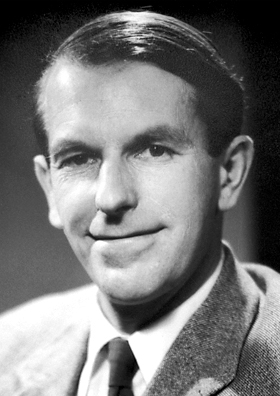Molecules of Life
Today, we read the molecules of life. The University of Houston's college of engineering presents this series about the machines that make our civilization run, and the people whose ingenuity created them.
Most of our body functions depend on proteins. These important food components are chains of amino acids arranged in a certain order. They fold into unique shapes and become motors, enzymes, hair, etc., many complex machines far too small to see. Their sequences are specified by the chemical letters in our DNA, also called our genome.
Reading a human genome is very hard. Our genome is billions of letters along a strand of DNA 6 feet long! A full copy is squeezed into each one of our tiny cells. It dictates the sequences of our proteins, and when and where they're made. Reading our DNA has been described as "opening the Book of Life."
That book was opened, in large part, by Fred Sanger at Cambridge, England. He was the only person to win two Nobel prizes in chemistry. He developed key methods of reading both proteins and DNA. Sanger was an English Quaker, the son of a doctor. He studied at Cambridge, and was a conscientious objector in the years leading up to World War II. After the war, Sanger set out to sequence the diabetes hormone insulin. This was a bold choice, as it wasn't yet clear that proteins even had a defined sequence. His success settled the question. But it also raised the question of how the instructions were stored.

Fred Sanger in 1958
In the '70s, others found ways of copying DNA using the same enzymes that copy DNA in our living cells. Sanger had sequenced proteins by breaking them into fragments. For DNA he grew the fragments by interrupting the copying process. He added terminator poisons that stopped a few of the growing DNA chains at each step. They also labeled which letter was present at what position. With later improvements, this technique led to the first sequencing of a human genome. Sanger declined the offer of a knighthood, because, as he put it, "it would have made him different from other people."
Newer methods have taken over most DNA sequencing; but Sanger's method is still used. He's also honored by the Welcome Trust Sanger Center, the leading genome center in the UK. Today, it and similar centers in places like Houston, Boston, and Beijing sequence the genomes of thousands of people.
Being able to read genomes has transformed biology and medicine. Our fates are not entirely determined by our genome sequences. Identical twins have different fingerprints, for example, even though they have the same DNA sequence. But the genome sequence shapes everything from eye color to height. It helps determine if we can roll our tongues, or sleep after coffee, and if we sneeze in bright sunlight. The medical impacts of DNA sequencing are profound. Cancer's a disease of damaged DNA. DNA sequencing also helps predict our response to medicines — like warfarin, or our odds of getting diseases — like breast cancer or Alzheimer's. All these answers are written in Fred Sanger's Book of Life.
I'm Richard Willson, at the University of Houston, where we're interested in the way inventive minds work.
(Theme music)
More information:
See the information on Sanger and his work at the Nobel Foundation.
Sanger's obituary in The Guardian Newspaper.
See also this volume of Sanger's scientific work:
F. Sanger and M. Dowding, Eds., Selected Papers of Frederick Sanger: (With Commentaries) (Series in 20th Century Biology), (World Scientific Publishing Company, 1996.
For an overview of the late-twentieth century's advances in genomics, with Sanger's contributions in context, see R. Cook-Degan, The Gene Wars: Science, Politics and the Human Genome (W. W. Norton & Company, 1996).
The Sanger method of DNA sequencing is beautifully illustrated by animations available on-line, including especially this one: http://www.dnalc.org/view/15479-Sanger-method-of-DNA-sequencing-3D-animation-with-narration.html.
This episode first aired on March 14, 2014.